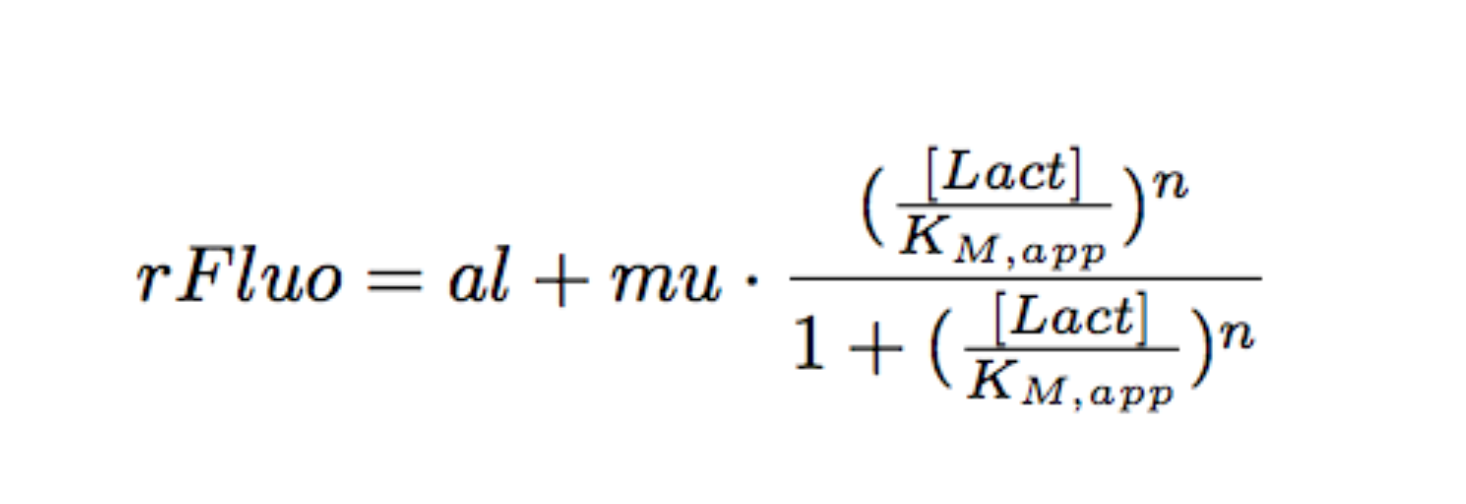Part:BBa_K1847011
lldRO1-placUV5-lacO-lldRO2
Promoter regulated by LldR and LacI.
Sequence and Features
- 10COMPATIBLE WITH RFC[10]
- 12COMPATIBLE WITH RFC[12]
- 21COMPATIBLE WITH RFC[21]
- 23COMPATIBLE WITH RFC[23]
- 25COMPATIBLE WITH RFC[25]
- 1000COMPATIBLE WITH RFC[1000]
Usage and Biology
The natural promoter of LldR (Part:BBa_K822000) consists of two operators (O1 and O2) and a promoter which is intercalated between the operators. It regulates the expression of the lldPRD operon, and it is involved in L-lactate metabolism. This promoter is repressed by a dimer of LldR, possibly by forming a DNA loop that does not allow the RNA polymerase to bind to the promoter. LldR can also have a function as an activator [1]. The repression of the promoter can be removed by lactate.
The lac operator is repressed by LacI. This repression can be removed by allolactose or by IPTG.
Characterization of the promoter
We wanted to know how the promoter would respond to the presence of lactate and/or IPTG, and how important is the architecture of the promoter in this response. For this regard, we built several promoters. Part:BBa_K1847010, Part:BBa_K1847011, and Part:BBa_K1847012.
Experimental Set-Up for LldR response
Plasmids
To test our double promoter we designed a plasmid containing the promoter with sfGFP in a medium copy plasmid and transformed it into Escherichia coli TOP10. Then, we added a second plasmid containing lldR with a medium strong promoter (Part:BBa_J23118) and a strong RBS (Part:BBa_B0034). Finally, we transformed another plasmid with LacI. LldR and LacI will repress the promoter. Upon addition of IPTG, LacI repression will be removed. Upon addition of lactate, LldR repression will be removed. Only when the two inducers are present GFP can get expressed.
Plate reader
E. coli TOP10 strains were grown overnight in Lysogeny Broth (LB) containing kanamycin (1 µ/mL), chloramphenicol (0.36 µ/mL) and ampicillin (1 µ/mL) as required at 37°C and 200 rpm. Cultures were diluted 1:50 in fresh LB with the corresponding antibiotic and transferred to a 96-well plate (200 µL/well). Cultures were grown for 90 min to arrive to exponential phase and then different concentrations of lactate were added. Samples were always made in triplicates and a blank of LB with the corresponding lactate concentration was done. During 7 h the absorbance at OD600 and fluorescence (excitation 488 nm and emission 530 nm) were measured with intervals of 7 min. The plate was always kept at 37°C. We calculated dose-response curves from the exponential phase of the bacteria.
Experimental Set-Up for lldR-lldP response
Plasmids
After the initial experiment with LldR, an L-lactate permease (LldP) was added to the plasmid to explore the possibilities when lactate import rates increase.
Plate reader
The same set-up as for LldR is applied.
We tried another set-up in which we added LldP into our LldR plasmid. LldP is an L-lactate permease which import L-lactate into the cell. A medium copy plasmid containing gfp activated by our synthetic promoter was always present in the cell. We used two different promoters in front of the lldRP operon, either medium strong (Part:BBa_j23118) or weak ([[]Part:BBa_J23114]).
FInally we combined the medium copy plasmid with gfp, the plasmid with lldP-lldR and lacI.
</ul>
Modeling
Each experimental data set was fitted to a Hill function using the Least Absolute Residual method (Fitting Toolbox in MatLab).
Where:
- al: leakiness in µM/min
- mu: constant in µM/min
- Km: half-maximum effective concentration (a representation of sensitivity) in µM
- n: Hill coefficient (a representation of cooperativity), unitless
| J23118-B0034-lldR | J23118-B0034-lldP-lldR | J23114-B0032-lldP-lldR | |
|---|---|---|---|
| Coefficient values | K=491.7 (91.34, 892) | K=2442 (511.1, 4373) | K=457.7 (271.7, 643.8) |
| al = 2220 (931.5, 3509) | al = 2396 (769.3, 4023) | al = 1.32e+04 (fixed at bound) | |
| mu = 8758 (7552, 9964) | mu = 1.57e+04 (9270, 2.212e+04) | mu = 6942 (5920, 7963) | |
| n1 = 0.7 (fixed at bound) | n1 = 1.156 (0.4928, 1.82) | n1 = 1.569 (-0.05875, 3.196) | |
| Goodness to fit | sse:5.0244e+08 | sse: 1.2664e+09 | sse: 1.2386e+09 |
| rsquare: 0.9767 | rsquare: 0.9852 | rsquare: 0.9569 | |
| dfe: 8 | dfe: 7 | dfe: 8 | |
| adjrsquare: 0.9708 | adjrsquare: 0.9788 | adjrsquare: 0.9461 | |
| rmse: 7.9250e+03 | rmse: 1.3450e+04 | rmse: 1.2443e+04 |
In the graph we can see that the promoter is more sensitive when it has LldP.
References
- J Bacteriol. 2008 Apr; 190(8): 2997–3005.
</div>
| None |



